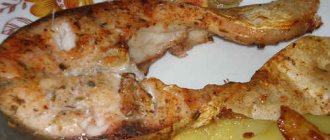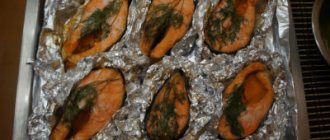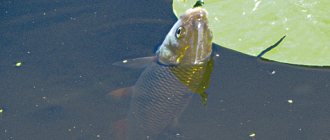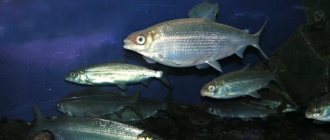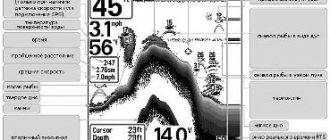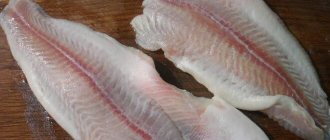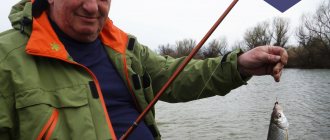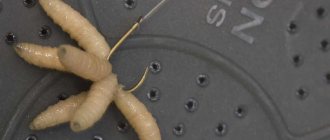Peled
- freshwater fish from the whitefish family. The maximum weight that a peled reaches is 5 kg, and its length is about half a meter. Peled is a northern fish, it is found in the basins of cold rivers of the Arctic Ocean, rivers of Siberia and the Urals and is considered a lake fish, since it prefers stagnant waters to flowing ones. The peled feeds on crustaceans, which is why its flesh has a very pleasant taste. In addition to industrial fishing, farm breeding of peled is also practiced, which is greatly facilitated by the unpretentiousness of peled to its habitat.
Description
Peled
Peled, or cheese, is a lake and river fish, a genus of whitefish. Peled (Obsk name “cheese”) is a medium-sized fish, endemic to Russian water bodies. The peled is easily distinguished from other whitefish by its terminal mouth, the upper jaw of which is only slightly longer than the lower jaw, and a large number of gill rakers (49-68). The body is tall, with a hump, light on the sides and in the ventral part, black spots on the head and dorsal fin. The mouth is finite, but the lower jaw protrudes somewhat. The back immediately behind the head is slightly humped. Between the dorsal and caudal fins is an adipose fin. The scales sit tightly and firmly on the body. The general background color of the peled is like that of a typical pelagic fish: the back and head are dark, the sides and belly are silvery. There are dark black spots on the dorsal fin and head. During the spawning period, white epithelial tubercles, the so-called “pearl rash,” appear on the body along the lateral line, which disappears after spawning.
Peled is characterized by high ecological plasticity and is capable of forming local forms that differ in morphology, growth rate, fertility and nutrition. Usually there are 3 forms: riverine, which lives in rivers and enters floodplain lakes to feed; lacustrine, which never leaves the lake and is characterized by good or slow growth; lake-river, the main part of its life is spent in the lake, and for reproduction it rises into tributaries. In some lakes a dwarf form of peled is found.
Peled is listed in the International Red Book.
How to increase your catch?
You should know not only where peled are found, but also how to increase your catch. To increase the number of fish caught, use several methods.
- Bite activator. Fish are attracted to cold and warm water by pheromones, which are included in the composition and improve their appetite.
- Sensitive gear.
- Lures with pheromones.
In March, ice breaks up in rivers and lakes. At this time, it is better to catch fish using small jigs with maggots. Ichthyologists believe that peled reacts to all moving objects.
Age and size
Body length can reach 40-58 cm and weight - up to 2.7 kg. Lake peled in the north of its range reaches a weight of up to 5 kg. Many lakes are inhabited by a dwarf form. Typically, river peled catches are dominated by individuals weighing 0.4-0.6 kg. River peled can mature at the age of 3 to 8 years, but spawn en masse in the sixth and seventh years of life. In some years, five-year-old fish may predominate among the producers. The maximum recorded age of peled is 13 years; under industrial pressure conditions, it rarely lives up to 9-10 years. The average fertility of peled in the Ob is 40 thousand eggs. Maximum - 300 thousand eggs.
How to salt Pelyad
Peled is a fish (the photo will help you accurately identify the product on the store counter), which can be deliciously prepared in several dozen ways.
For example, you can salt it yourself. It is important to choose the right fish for salting. Preferably fresh with silvery scales. If the product is frozen, it will need to be defrosted first. To pickle Peled, experienced chefs recommend using coarse sea salt. It is better to use glass or enamel dishes.
Composition of ingredients
For the dish you need to take:
- Peled – 900-950 g;
- salt (coarse sea salt) – 2 full tablespoons;
- beet sugar – ½ tsp;
- black pepper (in the form of peas) – 5 pcs.;
- table vinegar (6%) – ½ tbsp.;
- white onion (medium size) – 1 pc.;
- laurel leaves – 2 pcs.
Before salting, be sure to rinse the fish carcass thoroughly. If mucus is found on it, you should first rub the product on all sides with coarse salt, then rinse it off and only then start cutting.
Step-by-step cooking process
The cooking process includes several stages:
- The washed Peled should be cleaned and gutted as thoroughly as possible. Be sure to remove all excess from the inside of the carcass. You also need to cut off the head and rinse the product again under strong cold running water.
- Next, the prepared carcass should be cut into pieces and placed on the bottom of the selected container. For example, it is convenient to take a glass baking container with a lid.
- The onion should be peeled and chopped into thin rings.

- Afterwards, pour it on top of the fish along with salt, coarsely crushed bay leaves, and spiced peas.
- All that remains is to pour the vinegar on top. By the way, you can take more of it to taste. But ½ tbsp. – minimum portion.
In this form, the fish should be left cool for approximately 3-3.5 hours. For example, on a refrigerator shelf.
How to serve a dish
After just a few hours, you can try the original fish treat. Delicious served with boiled potatoes or other side dishes. You can also place fish on bread with vegetables to get hearty, healthy sandwiches. Another option is to add salted Peled cubes to salads.
Lifestyle
There are river and lake peled. They differ in their way of life by migration. Peled, compared to other whitefishes, is less demanding of oxygen, so it can live even in eutrophic lakes if the oxygen content does not fall below 2 mg/l. As a rule, it avoids flowing waters, concentrating in flood lakes, oxbow lakes, and channels. Is a schooling fish. Prefers lakes and quiet areas in rivers. Stays in the water column. Peled avoids places with abundant aquatic vegetation. In lakes and reservoirs, mature fish prefer to stay scattered in deep places in the summer. Juveniles can often be found in coastal zones with poorly developed vegetation. River peled, after opening the river to feed, enters floodplain lakes, rises into tributaries over short distances, and is found in feeding channels and oxbow lakes, sticking to open areas in them. The duration of feeding is determined by the level and time of standing water. As the water level drops, peled leave their feeding ponds and return to the river.
Where is peled (cheese) found?
Peled (cheese) lives in fresh water reservoirs from Karelia to Kolyma, from the Mezen River in the Arkhangelsk region to Lake Ilirney, located in Chukotka. This fish does not go into salty sea water, preferring to stick to its usual places of residence. It can be found in rivers flowing into the Arctic Ocean, as well as in the Amur basin.
The cheese does not particularly favor places with strong currents, which means you should first look for it in:
- oxbow lakes;
- small channels;
- artificially dug ponds;
- natural lakes;
- floodplain lakes.
The favorite habitat of peled (cheese) is reservoirs with cool water and a bottom slightly overgrown with underwater vegetation. In summer, the cheese, especially young and strong individuals, tries to stay in depths where the water does not have time to warm up during the day. Read also: What kind of fish is omul
The river form enters floodplain lakes after a flood, formed after a river flood. However, it does not stay there long, eating and gaining strength. As soon as the water begins to subside, the river peled again rushes into its native element, where it spends the rest of its time until next spring.
Habitats
Peled inhabits lakes and rivers from Mezen in the west to Kolyma in the east; it is not found in the Northern Dvina, just as it was not found in Western Europe and America (repeated attempts to describe it in Western Europe should be considered erroneous). Recorded in the lakes of the Kanin and Yamal peninsulas, found on Kolguev Island, occasionally found in the brackish waters of Kara Bay, but usually does not go out to sea. It does not go high up rivers.
In recent years, the range of peled has expanded significantly due to acclimatization work, and in many places broodstocks have been created or there is natural spawning of peled. Within the former USSR, its new range stretches from the Murmansk region in the north to Tajikistan in the south and from Germany in the west to Transbaikalia and Mongolia in the east. As a result of acclimatization, peled are now found in Germany, Poland, Slovakia, the Czech Republic, Hungary, Finland and Mongolia.
Cooking features
This fish is suitable for preparing a wide variety of dishes because it does not have small bones. It makes excellent snacks or hot dishes, plus fillings for making pies, pies and pancakes are prepared from such fish. Peled is salted very quickly, which allows you to prepare delicious snacks in your home kitchen without wasting too much time.
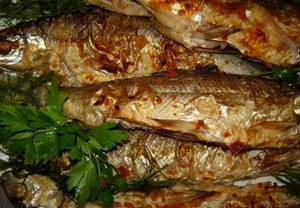
The marinated fillet has a piquant taste, which is also cooked within 3 hours. For the marinade, vinegar is used to regulate the sharpness of the taste. If you need to get a delicate flavor, then use a small amount of acid; if desired, you can use lemon juice. To obtain a sharper taste, the acidic component of the marinade is increased.
Hot dishes made from cheese are also valued for their excellent taste. Fried steaks have an excellent taste, and there are also many attractive recipes for preparing baked fish. In addition, peled is served stuffed or used to make fish rolls.
Spawning
In nature, peled matures on average at the age of six, but, acclimatized to lakes with a rich food supply for this fish, it becomes sexually mature at the age of two and three. Spawning begins at water temperatures below 8 degrees, often close to 0 degrees. The spawning substrate is usually pebble or sand-pebble soil. River peled begin to spawn in late September - early October, lake peled - in November - December. Spawning is annual or with a gap of one year. The incubation period lasts 150-230 days. In nature, the water temperature during the incubation period of eggs is about 0.2 degrees. At higher temperatures, eggs develop only in the first days after hatching. When hatching, the larvae have a body length of 8-9 mm and go through 5 stages of development. The transition to feeding on ciliates, cladocerans and copepods begins with the remains of the yolk sac on the 5-15th day after hatching, and the final transition to external nutrition begins on the 15-25th day. In nature, 5-12 days after hatching, the larvae begin to feed on zooplankton. Juveniles become fry when they reach a body length of 31-36 mm.
Survival and fish productivity
The survival rate in the first summer of life in ponds is 80% of the number of planted larvae, in the second year 80-90% in ponds and 60% in lakes of the number of planted fingerlings. After the third year, the growth of peled slows down, so it must be caught from lakes. Peled, unlike other whitefish, is less demanding of the oxygen regime; raw fish tolerates low water temperatures (about 0°C).
| On a note. Fingerlings of cheese fish tolerate wintering well in carp wintering quarters. The oxygen content should be about five mg/l, the planting rate for peled fingerlings should be up to one hundred and twenty thousand per hectare. The permissible waste of peled during the winter is up to fifteen%. |
In recent years, fish farmers have been creating wintering complexes for young fish of the year, which are pools in indoor greenhouse-type premises. The pools are buried 2 meters into the ground, have dimensions of 10 by 3 by 1.5 meters, the volume of water is about 36 cubic meters. Pools for whitefish are made of metal coated with polymers, the room is heated, and each pool has its own water supply.
Peled wintering is carried out at a water temperature of 0.7°C. The density of fingerlings weighing 40 grams is 120 pieces per 1 cubic meter, the waste of peled fish is 2.5%.
The fish productivity of shallow lakes when peled is grown together with carp is 100-120 kg/ha, and in ponds up to 250 kg/ha. It is recommended to grow peled in large ponds (100 hectares or more).
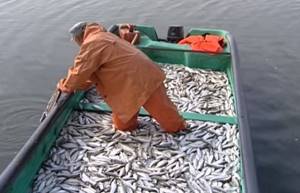
Photo of cheese fish catch
When kept in cages, peled breeders become fluid in December at a water temperature of about 3-1.5° C.
Fishing methods
Peled fish
Peled is caught all year round; it prefers cold water and stays in pools. Typically, the size of the fish increases in size the larger the body of water in which you catch it. You can determine the location of peled by splashes and characteristic circles on the water. Peled are caught with seines and gill nets in the spring when they go out to pasture, in the summer during the feeding period, and in the fall - winter during the spawning period, but in fishery reservoirs where acclimatization work is carried out, catching it is prohibited.
In winter, peled are caught using a regular fishing rod with a jig, lowering it just below the ice level. In summer, they are caught using float tackle without a sinker or fly fishing with a long rod, about 5 meters. You need to cast the bait further from the shore and keep it at a distance of about 1 meter from the bottom.
The bait can be mosquitoes, worms, bloodworms, maggots, amphipods, gammarids, and shellfish meat. Bait is usually not used; if you really want to, you can lure it with a jig.
The peled bites quickly and sharply, hitting the line; you need to hook it right away, but not sharply, because The peled's lips are weak. When fishing, a large specimen resists fiercely; patience and a supply of fishing line are required to pull it out. The peled is very shy and requires camouflage and silence to catch it.
Contraindications and indications
Thanks to a large number of microelements and unsaturated fats, this product has a lot of beneficial properties and is recommended by many:
- pregnant women;
- nursing mothers;
- small children from 2 years old;
- people during periods of great physical or nervous stress;
- To old people;
- patients with diabetes mellitus.
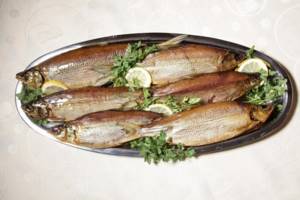
Meat is indicated for use even by people who cannot eat fatty foods or who are prone to allergies. Thanks to this product they can diversify their diet.
This product has its contraindications. Thus, peled fish should not be consumed raw, as it can cause the disease opisthorchiasis, which is transmitted by parasites. Infection with this parasite can lead to:
- peritonitis;
- inflammation of the pancreas;
- hepatitis or liver inflammation;
- cholelithiasis;
- a sharp decrease in immunity.
To avoid such consequences, the carcass must be carefully processed before consumption.
Fishing
Peled is a valuable commercial species and is used as an object of artificial breeding, as well as hybrids of peled with other whitefish species. It breeds successfully and has a good growth rate. Good growth, undemanding to water quality, use of feed that is not eaten by other fish. Recently, lakes in the north-west of our country, which previously had no fish, have been stocked with peled. At the same time, it often surpasses its whitefish relatives in growth intensity and weight, without losing the taste of the meat. When grown by the autumn of the third year of life, its length reaches 33 cm, weight 690 g, and in the fourth year - 1120 g. The dwarf lake form rarely reaches 500 g in weight, as a rule, it is much smaller. Like other whitefish, peled spawn in the fall, often already under the ice.
In places where the peled fish is found, it is considered a very valuable commercial fish, but the gross volumes of its catch are small. Even in Soviet times, the maximum volumes of its catch were only about 200 tons. Today the scale is even smaller. The low intensity of harvesting is not due to small fish stocks, but to the fact that peled lives in the inaccessible and practically deserted northern regions of the country. Recreational and commercial fishing is carried out locally near a few settlements in the Arctic.
Considering the scale of the annual peled catch, there is no need to talk about industrial fishing. But in the northern regions, peled is an object of sport fishing. They catch it throughout the year, since it does not hibernate in winter. The main problem of amateur fishermen is that peled is extremely shy, so it is extremely difficult to catch it with a fishing rod. This requires extreme silence and camouflage.
Fishing for peled
This fish can be caught at any time of the year. The cheese does not like dense vegetation and running water. Peled is a schooling fish species and lives primarily in the water column. Sometimes the fish rises to the top or dives to the bottom of the reservoir.
Peled is a very shy fish, so experienced fishermen recommend going to the nearest bushes when fishing and even wearing a camouflage suit. To successfully catch cheese, you need to take into account some features:
- if there is no plankton, it feeds on bottom organisms, so it rarely takes the usual bait;
- characterized by weak lips, which immediately tear when sharply hooked, the fish can suddenly grab the bait and go to depth;
- Due to shyness, it is better to fish in complete silence.
Peled fishing in summer is done using a fishing rod. For bait they take mosquitoes, worms, bloodworms, and less often maggots.
In winter, the cheese is caught using a jig. In ice fishing conditions, you need to darken the hole by covering it with snow. To catch peled in winter at the end of the season, fishermen often use dried or frozen bloodworms for bait. To enjoy delicious food, the cheese rises up and begins to actively peck.
In order for the catch to be successful, it is recommended not to lower the jig deeply, but to move it from the bottom wall of the ice with a distance of no more than 10 cm. You should hook the fish carefully without sudden movements. If there is no bite in the upper layers of water, then you need to fish the middle and then the lower layers of water.
Since the cheese is a predatory fish species, it can be successfully caught using a spinning rod. For such fishing you will need a lightweight ultralight rod equipped with a small spinning reel. To catch peled, it is better to use the following types of artificial bait:
- wobblers up to 3 cm long and up to 1.5 m deep, simulating large insects;
- small spinners No. 000–0;
- miniature twisters.
In the summer, when there is an active emergence of insects, fly fishing gear shows good results. Fishing can be carried out both with sinking and floating imitations of insects, as well as with nymphs and emergers.
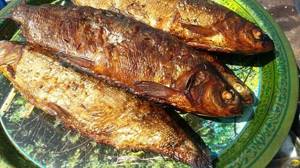
Only peled that has undergone high-quality heat treatment can be safe for human health.
The cheese bites well not only in open water, but also from ice. For winter fishing, jig tackle is best suited, including a monofilament line with a diameter of 0.14–16 mm and a small tungsten jig. The bait can be a dung worm, maggot or bloodworm. In the cold season, the fish sinks to the bottom layers of water and bites 0.5–1 m from the bottom. In winter, peled can be collected under the hole using bright trout bait.
In many regions, cheese is listed in the Red Book, therefore, when going to catch it, you should carefully read the rules of amateur fishing in a particular body of water.
Catching peled has some difficulties, which is not typical for other marine life.
- If there is no plankton, it eats bottom organisms, so it usually does not take standard bait.
- This fish does not like a sharp hook because its weak lips are torn. Due to the sharp fishing, it goes into the depths.
- Peled are considered shy, so fishing should be done in silence.
Fishing occurs all year round: in winter and summer. You can find its habitat by looking at special circles and splashes in the water: the peled loves to have fun. For winter fishing, a regular fishing rod is used. In summer it is better to use a float rod without a sinker. Fly fishers with a 5 meter rod, seines and gill nets are suitable.
This is usually done using gillnets or seines, although hook and line gear can be used. Fishing methods: fly fishing or a float rod, but without a sinker, for mosquitoes and midges. It is preferable to take a long rod, at least 5 m. A fishing line is required with a cross-section of 0.2-0.3 mm. The hook should be No. 4-5.
Peled is a shy fish. You need to cast the bait far from the shore. Camouflage in vegetation is important. It is recommended to fish in complete silence.
Properties
Beneficial features
Eating peled has a fairly wide range of positive effects on the body. The beneficial properties of peled fish begin with the fact that it is rich in a whole complex of macro- and microelements that promote cell restoration and normalize the functioning of the nervous system. Peled meat contains a large amount of chromium, which is needed to maintain optimal blood sugar levels.
Regular consumption of peled helps normalize sleep and prevent depression and irritability. This fish is also noted to be effective in combating constipation and bad breath. The substances contained in the meat of this fish help improve skin condition.
By systematically introducing peled into your diet, you can overcome chronic fatigue and improve concentration. The meat of this fish has a beneficial effect on the digestive system, including helping to fight cramps and stomach pain. Potassium, which peled is rich in, normalizes the functioning of the heart muscle, and phosphorus optimizes the functioning of the reproductive system, especially in women.
Peled is a good preventative against atherosclerosis, as it reduces cholesterol levels. It is also good as a dietary product, because its calorie content is only 126 kcal per 100 g.
However, you should not overuse it, because consuming peled in large quantities may cause nausea, abdominal pain, and even an allergic reaction. This is especially true for young children.
Harmful properties
Peled fish (curd)
Despite the abundance of positive aspects, raw fish is not so safe:
- It is not recommended for use by children under one year of age.
- Frequent consumption, more than 4 servings per week, can cause allergic rashes, heaviness in the stomach and even cause nausea.
- Peled that has not passed sanitary control or is caught in dirty waters may be infected with opisthorchiasis worms.
However, this does not mean that you cannot eat fish. As with any product, it is important to use caution and moderation, paying attention to how your body reacts.
Raw fish - benefits and harms
The cheese belongs to the whitefish and is found in northern latitudes. It was no coincidence that the fish received its original name; the reason for this was the peculiarity of its preparation. The reason for this is one feature - the cheese is suitable for consumption literally after 3 hours after salting. So it turns out that this dish is served almost raw.
In addition, the fish has another name - peled. In terms of external features, there are no differences between the two names. However, local fishermen fundamentally establish the difference between the lake variety, calling the fish peled and its semi-migratory form, called cheese.
Negative qualities
The chemical composition of the cheese is enriched with a concentrated content of microelements necessary for the body.
When consumed correctly, fish is able to fulfill the basic needs of the human body, providing it with the necessary amount of mineral components .
However, the rich chemical composition of the product has its drawbacks. If the rules of use are abused, tissue oversaturation with minerals can occur, which leads to:
- Nausea.
- Headaches.
- Indigestion.
- Heaviness in the stomach.
- Allergic reactions (especially in children).
To avoid side effects, you should not include the product in the menu more than 4 times a week . It is also not recommended to add such fish to a diet intended for children under one year of age. Nutritionists advise using this useful product moderately and carefully, observing the body's reactions.
Reservoirs in which fish are caught may pose an additional danger. It is not recommended to purchase products that have passed sanitary control.
Breeding technology
To increase the profitability of the fish farming business, peled farming is traditionally combined with carp farming. In addition to increasing the productivity of the reservoir, this method is also good because the introduction of peled into the reservoir is an excellent prevention of helminthiasis in other fish, since peled eats copepods - an important intermediate link in the development cycle of parasites.
The general technology for breeding peled is as follows. At the first stage, caviar is obtained from previously prepared broodstock. For this purpose, selected females and males are released into small ponds, from where they can then be easily caught. In November, they are planted for ripening in separate flowing ponds indoors.
These ponds, with a volume of about 70 cubic meters, are made in an elongated shape. In order for the fish to feel good in them, the water must be completely renewed every 8 hours. No more than 1.5 thousand producers can be placed in one such pond. The spawners ready for spawning are sent in batches of 250 pieces to small pools (4-5 cubic meters in volume), where the eggs are selected. Usually males are used several times (2-3), taking breaks between uses of two to three days.
The fertilized eggs are sent to an incubator, which provides the embryos with optimal oxygenation and pH levels. Depending on the selected temperature settings, the incubation period lasts from 123 to 145 days. During this period, preventative washing of the caviar with special solutions is carried out from time to time. After the larvae appear, they are sent to cages, and after 6-7 days they are ready for active feeding.
The fry are released into the fingerling pond, where they grow together with the carp. Planting density is 20-25 thousand larvae per hectare. Ponds with a depth of no more than 3 meters and an area of 15 to 20 hectares are optimal. In this case, the level of siltation does not matter at all, since the peled leaves the reservoir along with the drained water. Ponds containing young fish do not require filtration until the young of the year are two months old. Only at this age it is necessary to create flow of the reservoir.
Chemical composition
Peled contains about 13-15% fat, which is quite high. The fat gives the fish tenderness and a light texture; it is not heavy or rich. Meat contains virtually no carbohydrates, so it is suitable for many diets.
The chemical composition and calorie content of cooked peled fish depends on the method of its processing.
Depending on the preparation method, the product for every 100 g contains:
- Raw: 126 kcal, 19 g protein, 5 g fat, 2 g carbohydrates.
- Boiled: 108 kcal, 17 g protein and 4 g fat.
- Salted: 156 kcal, 19 g protein, 8 g fat, 2 g carbohydrates.
- Cold smoked: 150 kcal, 23.5 g protein, 6.4 g fat.
- Hot smoked: 189 kcal, 20 g protein, 14.6 g fat, 3 g carbohydrates.
- Dried: 126 kcal, 19.3 g protein, 5.4 g fat.
- Fried: 151 kcal, 23 g protein, 6.5 g fat.
Since lipids or fats are contained here in an unsaturated form, they are easily digested and are not stored as fat deposits.
Also, these living creatures contain large amounts of phosphorus, chromium, calcium, potassium, magnesium, sodium, zinc, and iron. Phosphorus in this meat contains up to 28%. It contains a lot of vitamin PP, which is rarely found anywhere. The iron in the product is easily absorbed and enters the blood. This microelement is responsible for saturating tissues with oxygen. Thanks to this, tissues receive better nutrition, metabolism increases, and toxins are eliminated faster. As a result, a person’s performance increases, body tissues are renewed faster, and therefore become younger.
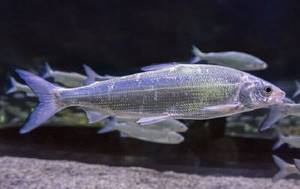
Low carbohydrate content and high saturation of useful elements allows you to include fish in your diet for weight loss.
Peled in the oven with zucchini and thyme
This version of cooking Pelyad can be called dietary. It will especially appeal to those who adhere to healthy eating rules. Ready-made treats can be added to your menu even during a strict diet. For example, serve it for lunch to stay full for a long time, but without consuming extra calories.
Composition of ingredients
For the dish you need to take:
- Fresh peled – 900-950 g;
- zucchini and carrots – 180-200 g each;
- lemon (medium size) – 1 pc.;
- sweet onion – 80-100 g;
- thyme – 3-4 sprigs;
- butter and salt.
It is best to use olive oil or other most beneficial oil.
Step-by-step cooking process
The cooking process includes several stages:
- A pre-washed fresh fish carcass must be gutted and cleaned of all excess. It is advisable to treat it again with a stream of cold water.

- To make Pelyad with a bright, rich taste, you should definitely treat it with crumbled thyme and salt, both outside and inside. This should be done as carefully as possible. You can use any other spices to your liking. The main thing is not to overdo it with them.
- All vegetables need to be washed. Carrots and zucchini should be peeled and only then cut into slices. Peeled onions need to be chopped into half rings. Vegetables must be mixed and divided into portions according to the number of fish. Since by weight there can be two or three of them.
- The foil should also be cut according to the number of fish pieces. It is also necessary to lubricate it with the selected vegetable oil. Even coconut will do.
- You should first place half a portion of vegetables on the prepared pieces of foil, and fish on top. Close Peled with the remaining vegetable mixture and sprigs of fresh thyme.
- After packing the products, the pieces should be placed on a baking sheet.
In an oven preheated to medium temperature, bake the treat for about a quarter of an hour. At the end, you should cut the fish with a sharp thin knife and check its readiness inside. If necessary, you can add a little more baking time.
How to serve a dish
The treat can be served directly in the foil, after slightly unrolling it. But you can also transfer the fish and vegetables to plates. On top you should decorate the dish with halves of fresh cherry tomatoes and sprigs of dill. You can also serve the treat with pickled vegetables and fresh bread.
How to cook Peled in pots
Peled is a fish, photos of which can often be found in cookbooks; it tastes very interesting with tomato paste. Tender fish is baked in pots with cream, pickles and other additives. You should definitely use green onions for this recipe. It adds brightness to the treat, makes it tastier and more interesting.
Composition of ingredients
For the dish you need to take:
- Peled – 550-600 g;
- white onion and pickled cucumbers – 150-200 g each;
- green onions (feathers) – 20-25 g;
- potatoes – 270-300 g;
- butter fat, tomato paste, medium fat cream - 55-60 ml each;
- filtered water – 2/3 cup;
- salt, spices.
Step-by-step cooking process
The cooking process includes several stages:
- Already peeled and washed onions should be chopped. Preferably in cubes. If your family is not too fond of this vegetable in dishes, you should just make its pieces very small. It makes the treat especially tasty and juicy.
- Potatoes also need to be peeled and then cut. It is best to chop this vegetable into thin slices.
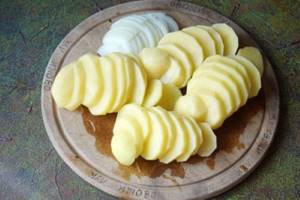
- The fish (already washed and cut) must be cut into fillets. It is advisable to cut them into small cubes.
- Pickled cucumbers (pickled cucumbers are also suitable) should have their tips removed. The remaining parts of the pickles are cut into cubes and cubes. Their pieces can be anything to the taste of the cook.
- Place the butter in small pots. If desired, its quantity can be increased, but this will also increase the calorie content of the dish.
- The pots with oil should be heated in the oven at medium temperature for about 6 minutes. Then add chopped onion.
- After another 3-4 minutes of heating, you can add the potatoes and fill everything with water.
- Simmer the pots with the contents in the oven until the potatoes are soft.
- Separately, you need to mix the fish, tomato paste, and salt. These ingredients are sent on top of the already soft potatoes.
- After 6 minutes, all that remains is to add the pickles and pour the contents of the pots with cream. You can add any spices to your taste. But even without them you get a very tasty, aromatic dish.
Afterwards you can prepare the treat at 190-195°. After mixing the contents of the pots, you should leave them in the oven for another 6-7 minutes.
How to serve a dish
The already completely prepared treat should be sprinkled with finely chopped green onions. You can take more if you wish. It is also possible to add other greens.
